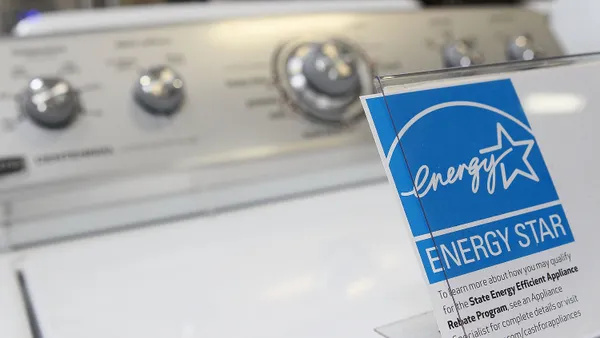Dive Brief:
- The U.S. Department of Energy (DOE) has published a strategic plan designed to help meet the Obama administration's goal of doubling the nation's energy productivity within the next 15 years.
- The report, "Accelerate Energy Productivity 2030: A Strategic Roadmap for American Energy Innovation, Economic Growth, and Competitiveness," posits that families will be able to power their homes and vehicles using less energy, while businesses boost manufacturing at a lower cost and reduce harmful emissions.
- Strategies include having states secure energy productivity through vehicle and product codes and standards, providing energy performance information to consumers and redesigning energy rates and policies.
Dive Insight:
Can the United States double its energy productivity by 2030? President Obama set the goal last year, and his administration has developed a coalition of energy players and a set of strategies that they believe will make this achievable.
Alliance to Save Energy President Kateri Callahan called the plan an "actionable blueprint," saying she is “bullish on our prospects for achieving a doubling of energy productivity in the U.S. because it just makes good economic sense."
Federal officials say cutting energy waste and doubling productivity will help American families save money on their energy bills, enable businesses to produce more while using less energy and strengthen the U.S. clean energy economy.
“This roadmap provides a path for families, businesses and governments, among others, to follow. By taking steps to increase efficiency and cut waste, the U.S. will be more competitive globally and will see direct and long-lasting benefits for decades to come," said Energy Secretary Ernest Moniz in a statement.
Two major findings stand out in the report: demonstrated, proven opportunities in every part of the economy to improve energy productivity that also contributes to economic growth.
The plan calls for the federal government to invest in research and development in the transportation, building, and manufacturing sectors. At the state level, representatives can pursue policies to encourage greater energy efficiency; promote new and innovative financing for investments that support energy productivity and incentivize increased deployment of combined heat and power.
Electric utilities can modernize grid infrastructure through "smart grid investments and improving the efficiency and interoperability of generation," the report finds, in addition to investments in transmission, storage, and distribution. The plan also envisions adopting new utility business models to "empower
the improvement of energy productivity; design rates and support related policies for utility energy efficiency programs that more effectively align energy efficiency with utility business models; and support energy productivity investments in buildings."
This finding also aligns with the DOE's push to bolster cooperation between electrical utilities and the agency in order to meet the Obama administration's climate change and renewable energy goals by moderizing the grid.
Council on Competitiveness President and CEO Deborah Wince-Smith said the plan "makes the compelling competitiveness case for a doubling of national energy productivity – as an engine for job creation; economic growth; a more globally-competitive manufacturing base; and a greater standard of living for every American.”













